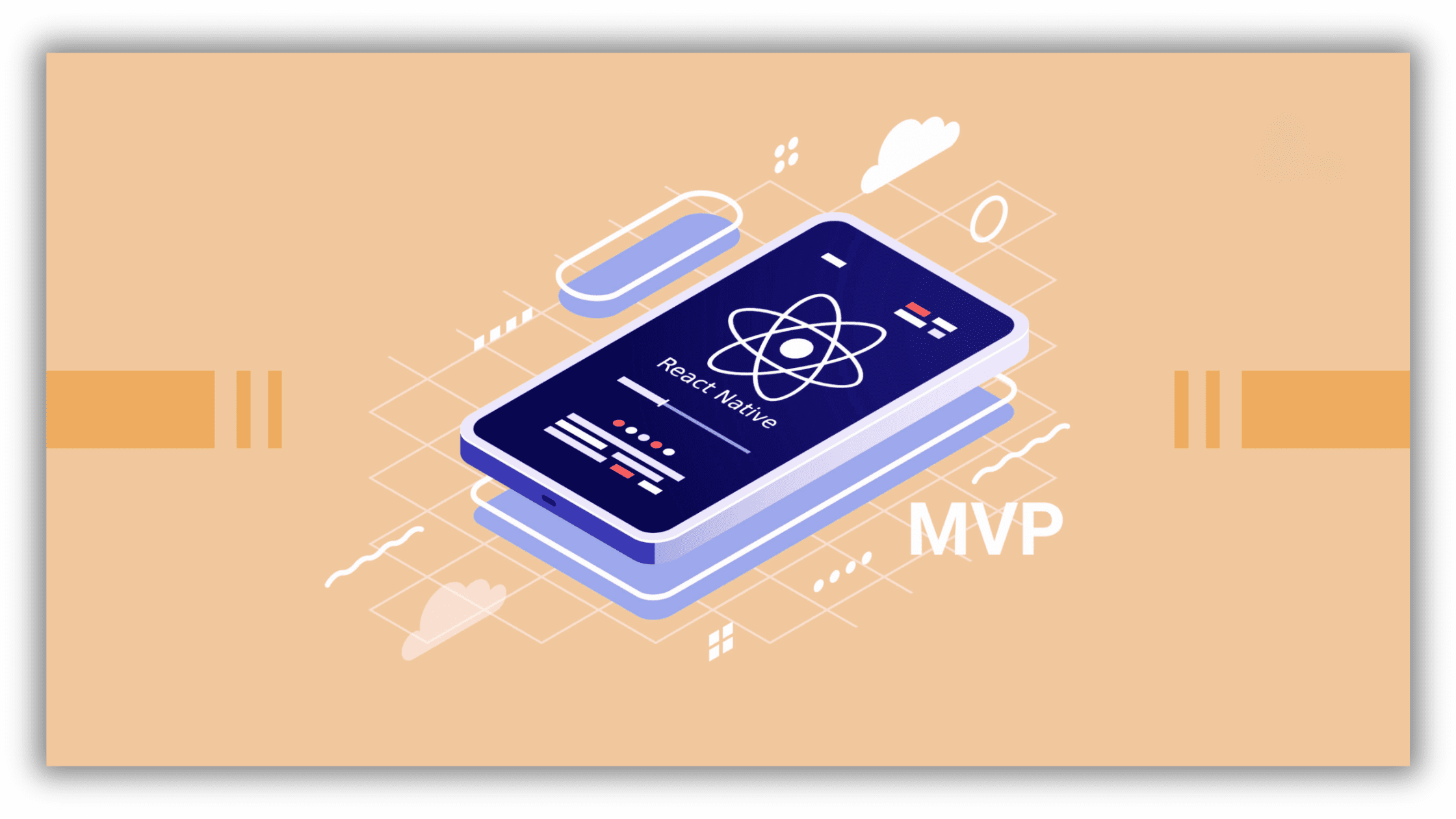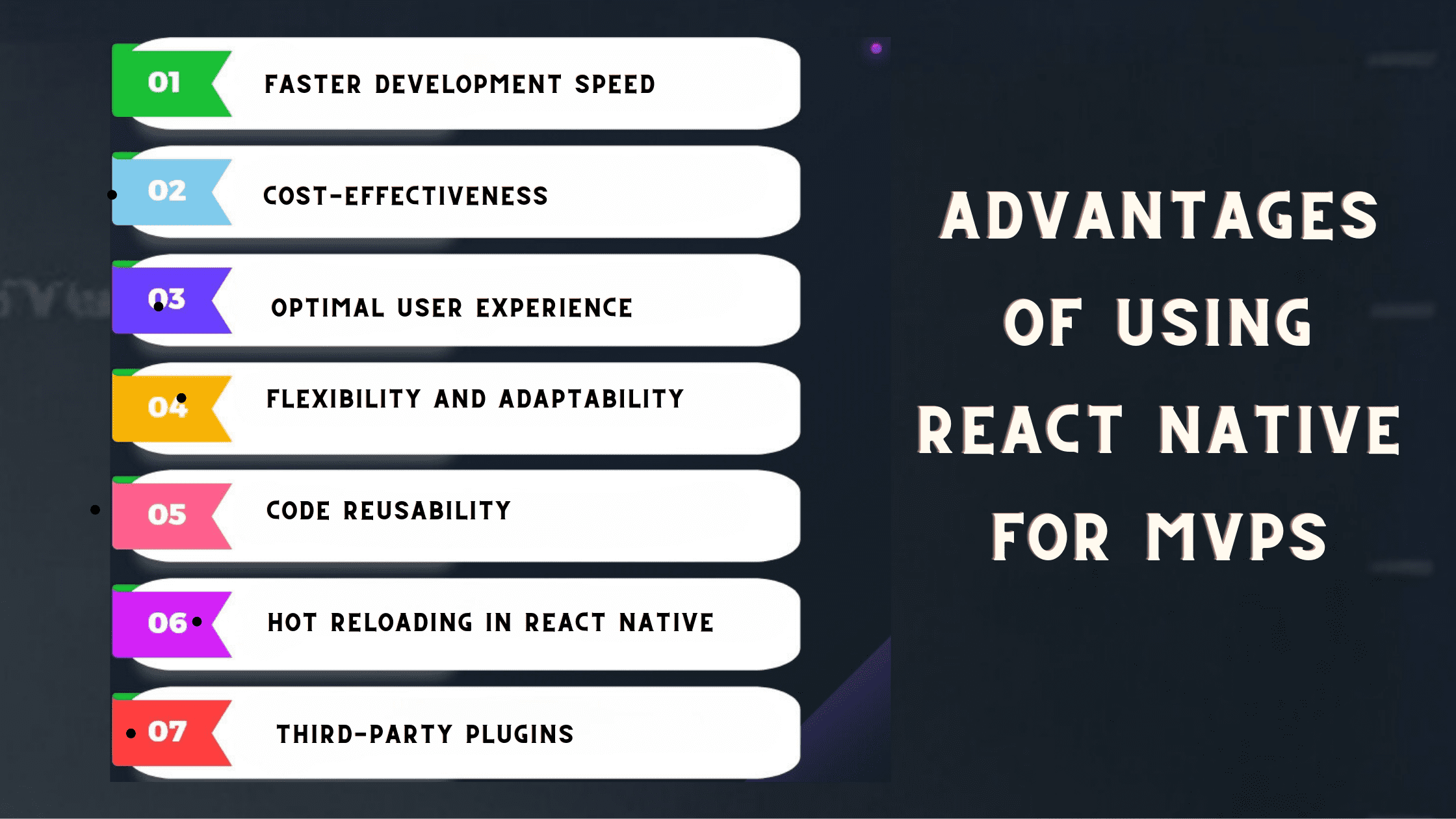An MVP (minimum viable product) is an early, basic version of a product built to validate a concept and get market feedback. MVPs focus on core functionality rather than the intricate details of a product. In the domain of mobile app development, React Native is a popular framework that uses JavaScript and React architecture. It has a host of benefits that lend itself well to building MVP apps efficiently. Let’s explore the key advantages and features of using React Native for MVP development:
Why You Need MVP for Software Development
Before diving into the specifics of React Native for MVP development, it’s crucial to understand the importance of MVPs in the software development lifecycle. An MVP serves as the initial version of a product, containing the core features necessary for its functionality. The primary purpose of an MVP is to validate the concept, test assumptions, and gather user feedback to make informed decisions about future development.
By adopting an MVP approach, businesses can mitigate risks associated with investing time and resources into a full-fledged product without understanding its market reception. MVPs enable rapid iteration and refinement based on fundamental user interactions, ensuring the final product aligns with user needs and preferences.
Advantages of Using React Native for MVPs
- Faster Development Speed
- Cost-Effectiveness
- Optimal User Experience
- Flexibility and Adaptability
- Code reusability
- Hot Reloading in React Native
- Third-party plugins
Faster Development
A significant benefit of React Native is faster development compared to native platforms like Java or Kotlin for Android and Objective-C/Swift for iOS.
Reasons React Native accelerates building include:
- Cross-platform code reuse – Apps for both iOS and Android can leverage a single shared React Native codebase instead of separate code written natively for each operating system. It saves huge amounts of programming effort.
- Available components – React Native offers many readymade UI components like forms, buttons, inputs, etc. Developers don’t need to build these common elements from scratch, saving time.
- Hot reloading capability – Instantly view code changes in simulators without rebuilding, which speeds up product iterations.
- Third-party libraries – Import useful features like payments and analytics rather than coding manually.
- JavaScript skills – JavaScript/React skills transfer easily to React Native instead of learning platform-specific languages needed for native.
For fast, affordable proof-of-concept app builds, React Native streamlines development significantly compared to native options that take much longer.
Speed
Besides faster coding timeframes, React Native also produces high-performance mobile apps thanks to its compiled code architecture. It converts JavaScript to native binaries for each target OS rather than interpreting code at runtime like hybrid tools such as Cordova.
This ahead-of-time compilation, combined with additional performance optimizations like asynchronous data storage, selective rendering, and more, enables snappy 60 frames-per-second rendering even on large complex applications comparable to native.
This level of responsiveness for MVP testing allows for reliably gauging real-world app viability without performance bottlenecks skewing feedback. Slow, laggy apps fail even brilliant ideas. React Native provides full-featured speed for validation.
Cost-Effectiveness
The development speed advantage additionally makes React Native extremely cost-effective for creating MVPs compared to native platforms that take more time.
React Native’s cross-compatibility further makes it economical by only needing one codebase maintained instead of separate iOS and Android versions. It reduces long-term overhead costs.
Teams also benefit from abundant free, open-source React Native libraries and existing JavaScript skills rather than expensive mobile specialists needed for native builds.
Startups specifically appreciate React Native’s cost savings in bootstrapping concept viability without high initial investments that risk bankrupting ideas before getting market feedback.
For most new ideas, React Native fits budgets better while still delivering quality experiences.
Optimal User Experience
React Native prioritizes smooth, native-like interactivity by directly tapping into fundamental UI components of each OS rather than a generic cross-platform UI layer.
It means apps feel highly responsive with no lagginess or compromise on platform conventions that users expect.
MVP testing requires realistic platform environments for feedback validity. React Native provides consistency with native expectations across major mobile operating systems for reliable user response data collection.
Flexibility and Adaptability
As an MVP progresses from early hypothesis testing towards validated product-market fit and beyond, apps grow in complexity with additional required functionality and scale needs.
React Native flexible architecture adapts well in these scenarios to extend capabilities compared to some strictly limited no-code mobile app builders more suited to only basic use cases.
Reasons React Native sustains growth include:
- Platform APIs – Direct access to native device APIs like camera and geolocation provides future extensibility.
- Scalability – Proven capability for large, complex apps with substantial user bases, including Facebook, Instagram, and Walmart.
- Expandability – Dropping into native code for performance-critical sections boosts capability while keeping the majority cross-platform.
- Third-party components – Thousands of open-source libraries add advanced features.
- Tools – Supports modern mobile dev workflows, including CI/CD automation.
React Native flexibility future-proofs apps, allowing evolved sophistication from simple MVP origins.
Code Reusability
Besides the significant time savings during initial app builds, React Native’s cross-platform JavaScript codebase also massively reduces the complexity of maintaining feature parity long-term across both major mobile OS ecosystems.
Rather than implementing unique native code per platform, the same React Native logic quickly deploys across iOS and Android through a single code reuse strategy.
This significantly lowers overheads around synchronization, redundancy, and translating product changes into multiple languages needed for disjointed native code bases.
For resource-constrained startups, react Native code sharing simplifies product evolution as platforms grow more advanced in capabilities.
Hot Reloading in React Native
A hugely helpful React Native developer capability is the hot reloading of code changes instantly inside mobile simulator screens during programming sessions without needing to rebuild entire apps from scratch each time.
This rapid iteration flow hugely accelerates development velocity in implementing and validating UI adjustments, business logic changes, and visual tweaks across app screens.
For MVP builds needing frequent adjustments, hot reloading gives near-instant app feedback that cuts central time over native platforms needing full recompiles and reinstalls, slowing things down.
Third-Party Plugins
The expansive React Native open-source ecosystem provides possibly the most comprehensive access to third-party libraries compared to any other mobile app framework. The react architecture lends itself well to component modularity and code sharing.
This sheer volume of high-quality community-maintained plugins offers developers readymade solutions for just about any common mobile app feature, from authentication and analytics to AR capabilities and more, without reinventing the wheel in-house at great time and cost savings.
Rapid prototyping needs this breadth of code library support to tap into full app functionality quickly without complexity.
Building an MVP with React Native: The Ultimate Guide
Now that we’ve established the significance of MVPs let’s explore how React Native, a popular JavaScript framework developed by Facebook, can be a game-changer in MVP development.
1. Understanding React Native
React Native allows developers to build mobile applications using the same codebase for both iOS and Android platforms. Leveraging the power of React, a JavaScript library for building user interfaces, React Native provides a robust and efficient framework for developing cross-platform apps with a native look and feel.
2. Setting Up Your Development Environment
To begin building an MVP with React Native, developers need to set up their development environment. This involves installing Node.js and the React Native CLI and configuring an emulator or a physical device for testing. The React Native documentation provides comprehensive guides for setting up the environment based on the target platform.
3. Creating a New React Native Project
Once the environment is set up, developers can use the React Native CLI to create a new project. This project will serve as the foundation for the MVP, containing the necessary files and configurations.
4. Building Components and UI
React Native follows a component-based architecture, where UI elements are created as reusable components. Developers can design the user interface of the MVP by assembling these components. React Native supports using JSX (JavaScript XML) to define UI components, making it easy for developers familiar with web development to transition to mobile app development.
5. Handling State and Logic
State management is a critical aspect of any application. React Native uses state and props to manage data and communicate between components. By efficiently handling state and logic, developers can ensure that the MVP functions smoothly and delivers a smooth user experience.
6. Integrating APIs and Services
Most MVPs require interaction with external APIs and services to fetch or submit data. React Native simplifies this process by offering built-in modules and libraries for making HTTP requests, handling asynchronous operations, and integrating with various services.
7. Testing and Debugging
React Native provides robust tools for testing and debugging applications. Developers can use the integrated debugger, logging, and testing frameworks to identify and resolve issues efficiently. Additionally, React Native supports hot-reloading, allowing developers to see the changes instantly without restarting the entire application.
8. Deploying the MVP
Once the development and testing phases are complete, developers can deploy the MVP to app stores or distribute it for testing. React Native facilitates the deployment process, ensuring the app meets the requirements for both iOS and Android platforms.

Why is React Native Better for MVP Development?
Now that we’ve covered building an MVP with React Native let’s delve into why React Native is an excellent choice for MVP development.
1. Cross-Platform Compatibility
One of the standout features of React Native is its ability to create cross-platform applications. With a single codebase, developers can target iOS and Android platforms, significantly reducing development time and effort. This cross-platform compatibility is advantageous for MVPs, allowing businesses to reach a broader audience with minimal resources.
2. Faster Development Cycle
React Native’s hot-reloading feature lets developers see the real-time changes, speeding up the development cycle. This rapid iteration is crucial for MVP development, where quick adjustments based on user feedback are essential. The faster development cycle provided by React Native allows businesses to iterate and refine their MVPs swiftly.
3. Cost-Effectiveness
Building separate applications for iOS and Android can be resource-intensive. React Native’s cost-effectiveness stems from developers’ ability to write code once and deploy it on multiple platforms. This reduces development costs and ensures consistency across different devices, providing a simplistic user experience.
4. Rich Ecosystem of Libraries and Modules
React Native has a vast ecosystem of third-party libraries and modules that can be easily integrated into the application. This rich ecosystem accelerates development by providing pre-built solutions for standard functionalities, allowing developers to focus on the unique aspects of the MVP.
5. Strong Community Support
A thriving community is a testament to the success and sustainability of any technology. React Native benefits from a large and active community of developers, ensuring that businesses adopting this framework for MVP development have access to a wealth of knowledge, tutorials, and support.
Companies that Used React Native for MVP
Several successful companies have embraced React Native for MVP development, achieving rapid growth and market validation. Let’s explore some notable examples:
UberEats
UberEats, Uber’s food delivery arm, used React Native to build parts of its mobile application. This choice allowed Uber Eats to optimize development time and resources while providing a optimized experience for users across different devices.
Unsurprisingly, Facebook, the creator of React Native, utilized the framework to develop parts of its mobile application. React Native allowed Facebook to maintain a consistent user experience across different platforms while optimizing development resources.
Airbnb
Airbnb, a global hospitality platform, adopted React Native for its mobile application. Using a single codebase allowed Airbnb to expedite the development process and ensure a consistent user experience for its diverse user base.
Instagram, owned by Facebook, also leveraged React Native for specific features within its app. The framework enabled Instagram to streamline development and deliver users a unified experience on iOS and Android devices.
Conclusion
There are countless advantages of utilizing React Native for effortless, rapid, mobile app development. Thanks to its benefits like cross-platform compatability, budget-friendliness, strong community support and feature-rich libraries, building an MVP with React Native is preferred by developers. Facebook and Instagram are just two of the many large enterprises that have built their mobile apps using the React Native framework.
Why Choose Canadian Software Agency For Your Next React Native Project?
At Canadian Software Agency, we have a team of mobile app developers with expertise in creating MVP using React Native. With more than a decade of experience in the field of software development, we have a considerable record in the region. If you are looking to avail of our services, contact us now.





